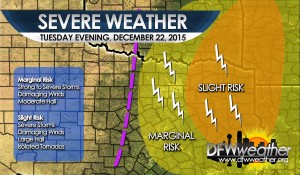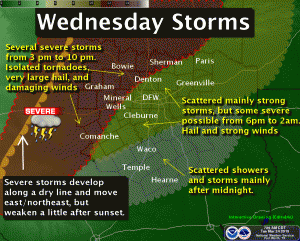The coming week is going to be a wet one for much of North Texas, including the DFW Metroplex. A very big upper-level low will be sinking south into Mexico and then ejecting east northeast slowly. The slow movement of this system will allow abundant moisture to stream into the region ahead of it. This is already noted with overnight low temperatures well above normal for this time of year.
Showers and thunderstorms will begin to fire tomorrow along a dryline in West Texas. At the same time a jet streak will be out across the Texas and Oklahoma panhandles juxtaposing North Texas in the right entrance quadrant of a speed max which will enhance lift across the area. Some hi-res models are forecasting convective development tomorrow as far east as the I-35 corridor. All storms that form should be supercellular in nature and elevated. With 1500 to 1800 J/Kg of convective potential energy, or CAPE, available, some of these storms could be strong to severe. Large hail would be the primary threats. In addition to the severe threat, heavy rainfall will also be possible as precipitable water values, or pWATS, climb above the 99th percentile for March. This could greatly enhance rainfall rates.
Monday night into Tuesday morning models are showing an MCS (mesoscale convective system) moving across North Texas with the potential for very heavy rainfall. The outflow boundaries from this system could act as foci for additional storm development on Tuesday as widespread lift begins to encroach on the area as the upper-level low begins moving east northeast. The MCS could also serve to help stabilize the atmosphere on Tuesday which would help alleviate the severe weather threat. While it is too early to pinpoint the mesoscale environment on Tuesday, it does appear all modes of severe weather will be possible on Tuesday, including tornadoes. A dryline will sharpen west of the Metroplex and act as focus for storm development as jet streak lifts out of the lower Rio Grande Valley. In addition to the severe weather threat, heavy rainfall will also be likely given the high pWATS. It is possible that Tuesday could see the daily rain record broken.
A weak cold front will push through ending the severe weather potential, but not the rain. Overrunning showers will likely continue. The remainder of the week looks to remain wet through Friday as north and central Texas remain on the eastern flank of the upper-level low. There won’t be significant drying until the upper-low moves far enough east by the weekend to end all rain.


